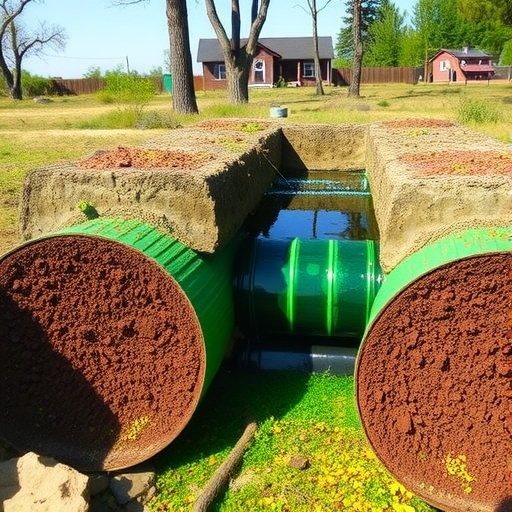In a groundbreaking study published in Environmental Earth Sciences, researchers Habibi, Fijani, and Haghiri present a comprehensive comparative assessment of hydraulic conductivity estimation techniques in alluvial aquifers. Their work addresses a persistent challenge in hydrogeology: accurately determining the permeability of alluvial sediments, which are critical for sustainable groundwater management, especially in regions heavily dependent on aquifers for drinking water and irrigation. The study’s findings promise to enhance both the technical precision and practical application of hydraulic conductivity estimations, which are essential for modeling groundwater flow and predicting contaminant transport.
Hydraulic conductivity is a fundamental parameter in hydrogeology that quantifies how easily water can move through porous media, such as the sand, gravel, and silts composing alluvial aquifers. The accuracy of hydraulic conductivity estimates underpins the reliability of groundwater resource assessments and plays a crucial role in the design of remediation strategies for polluted aquifers. However, due to the heterogeneous and anisotropic nature of alluvial deposits—formed by riverine processes depositing sediments of varying grain sizes—obtaining representative hydraulic conductivity values remains a technical and scientific hurdle.
The researchers embarked on an extensive evaluation of multiple prevalent estimation techniques, spanning laboratory, field, and computational approaches. Laboratory methods allow for controlled measurements of sediment samples in confined settings, often using permeameters to measure flow rates. Field methods deploy techniques such as pumping tests, slug tests, and tracer tests that directly engage with natural groundwater conditions, offering practical insights but vulnerable to the complexities of aquifer heterogeneity. Computational and empirical modeling approaches utilize statistical and geostatistical frameworks to estimate hydraulic conductivity based on sediment characteristics or borehole data.
One of the study’s pivotal contributions is the systematic comparison of these estimation techniques within a single geological context—a detail often lacking in earlier literature. By applying all methods to the same alluvial aquifer, the researchers eliminate confounding geological variables, thereby enabling a direct appraisal of technique performance. Their results highlight the trade-offs inherent in each approach: laboratory methods, for instance, deliver high precision on small scales but may not capture larger-scale heterogeneity, whereas field tests provide more representative bulk measurements yet are susceptible to boundary condition uncertainties.
Importantly, Habibi and colleagues critically analyze the scale dependency of hydraulic conductivity, a factor that profoundly influences aquifer characterization. Their findings reaffirm that hydraulic conductivity values are not constant but vary with the scale of measurement, reflecting the layered and non-uniform sedimentary structures typical in alluvial systems. This scale dependency suggests that integrating multiple methods, each capturing different spatial scales, yields a more nuanced and realistic estimation of aquifer permeability.
The research further advances understanding through its treatment of parameter uncertainty. Employing rigorous statistical analyses, the authors quantify confidence intervals and probability distributions associated with each estimation method. This probabilistic approach acknowledges the inherent variability and measurement errors, offering water resource managers a clearer picture of reliability when making critical decisions. Such transparency is essential for building robust groundwater models used in risk assessments and policy formulation.
Technologically, the study benefits from recent advances in sensor technology and data analytics. High-resolution sediment analysis, combined with machine learning algorithms, enhances the interpretative power of empirical models. These tools facilitate the identification of subtle sediment textural variations influencing hydraulic conductivity. The authors emphasize the potential synergy of combining traditional hydrogeological tests with state-of-the-art computational intelligence to refine hydraulic parameter estimates further.
The implications of this research extend beyond academic curiosity; they bear significant environmental and socio-economic consequences. Accurate hydraulic conductivity estimation informs sustainable groundwater extraction limits, preventing aquifer depletion and land subsidence. It also underpins the success of engineered interventions such as managed aquifer recharge and contaminant plume mitigation. In alluvial aquifers, which often lie beneath populous agricultural and urban centers, the stakes for sound hydrogeological characterization are particularly high.
Moreover, the study underscores the importance of site-specific assessments. Alluvial aquifers vary widely in sediment composition, depositional history, and hydrological settings. Therefore, one-size-fits-all estimation methods risk mischaracterizing aquifer properties. By validating multiple techniques at a single site, Habibi et al. provide a blueprint for localized hydrogeological investigations, promoting tailored approaches that respect geological complexity.
Intriguingly, the authors discuss the potential for remote sensing and geophysical methods to complement traditional techniques. While not the focus of the current paper, they allude to the promise of integrating surface geophysical surveys, such as electrical resistivity tomography, with hydraulic testing. These approaches can non-invasively map subsurface heterogeneity, offering valuable auxiliary data for enhancing hydraulic conductivity models.
The interdisciplinary nature of the study, bringing together hydrogeology, geostatistics, and environmental engineering, exemplifies the trend toward comprehensive groundwater science. Such integrative research is essential to address the multifaceted challenges of water security in the face of climate change, population growth, and anthropogenic contamination. By providing robust methodological evaluations, the paper empowers practitioners with better tools to safeguard vital water resources.
In conclusion, the comparative assessment by Habibi, Fijani, and Haghiri advances the state of the art in hydraulic conductivity estimation in alluvial aquifers. Their meticulous analyses not only clarify the strengths and limitations of existing techniques but also advocate for methodological pluralism and scale-aware approaches. This work sets a new standard for hydrogeological investigations and promises to influence groundwater resource management worldwide, contributing to both scientific knowledge and practical water sustainability.
Subject of Research: Hydraulic conductivity estimation techniques in alluvial aquifers
Article Title: Comparative assessment of hydraulic conductivity estimation techniques in alluvial aquifers
Article References:
Habibi, S., Fijani, E. & Haghiri, M. Comparative assessment of hydraulic conductivity estimation techniques in alluvial aquifers. Environ Earth Sci 84, 647 (2025). https://doi.org/10.1007/s12665-025-12650-1
Image Credits: AI Generated




